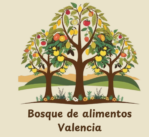A self-sustaining ecosystem designed to mimic a natural forest while producing food
Unlike conventional farms that require constant input and maintenance, food forests work with nature, fostering biodiversity, enriching the soil, and reducing water usage—all without the need for pesticides or synthetic fertilizers
Why Choose a Food Forest?
In the Mediterranean climate of Valencia, where water is precious and summers can be scorching, food forests offer a powerful solution for sustainable food production. By incorporating diverse layers of trees, shrubs, herbs, and ground cover, they create microclimates that retain moisture, improve soil fertility, and encourage beneficial insects.
A well-designed food forest:
- Produces healthy food full of nutrients
- Eliminates the need for pesticides by fostering a balanced ecosystem where natural predators keep pests in check.
- Regenerates the soil through organic matter accumulation and nitrogen-fixing plants.
- Uses water efficiently by shading the ground, reducing evaporation, and improving water retention.
- Boosts biodiversity by providing habitat for pollinators, birds, and other wildlife.
- Creates long-term resilience against drought and extreme weather.
In a food forest we are working with nature instead of against it. Instead of planting a monoculture of anual plants we are using a big diversity of perennial plants and trees which are direct or indirect beneficial to people but also for animals. Like at the forest edge we work in layers.
How does a food forest work?
- Canopy Layer – Tall fruit or nut trees such as almond, fig, or carob.
- Understory Layer – Smaller fruit trees like pomegranate, persimmon, or citrus.
- Shrub Layer – Bushes such as rosemary, lavender, and currants.
- Herbaceous Layer – Culinary and medicinal herbs like thyme, oregano, and basil.
- Ground Cover Layer – Clovers or strawberries that help retain moisture and suppress weeds.
- Root Layer – Edible tubers like garlic, onions, and sweet potatoes.
- Vine Layer – Climbers such as grapes or kiwis that make use of vertical space.






Each layer has its own function in the ecosystem like, shadow, nitrogen-fixing, wind protection, production of biomass, attracting pollinators, etc. The forest/soil is every year more fertile and is finally self sufficient without the necessity of big inputs of artificial fertilisers, pesticides and big machinery.




